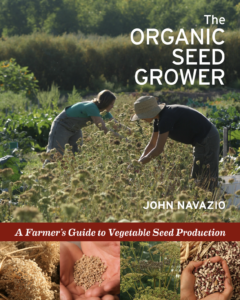“The Organic Seed Grower,” a Comprehensive Manual for the Seasoned or Novice seed Saver
John Navazio’s new book provides a detailed, step-by-step guide to saving seed on a commercial scale.
One of the first points that John Navazio lays out in his recently released book on seed saving,”The Organic Seed Grower,” is an often overlooked one: “Until very recently, the growing of seed was an integral part of all agricultural practice, in all agricultural societies” (VIII). It’s only over the course of the last century that farmers have — almost as a rule — stopped saving their own seed. A handful of seed companies now do it for us.

The Organic Seed Grower
As Navazio explains, this corporate control of seed selection has had consequences for farmers, including a loss genetic diversity and a flattening out of the marketplace. “Growers are seeing a real narrowing of the vegetable varieties that are commercially available, due in large part to the consolidation that has taken place within the seed industry,” Navazio writes (VII). And, those varieties that are available are not necessarily grown because of their fit for organic farmers. The varieties that excel in a seed company’s production plot may or may not be well-suited for the systems used by organic growers.
So, Navazio’s solution to the problem is an elegantly simple one: Growers need to start saving their own seeds, both for themselves, and on a (small) commercial scale. By saving their own seeds, farmers are able to select the varieties that are most meaningful to their systems, adapt them to the unique conditions on their farms, and build resilience into their business model.
The problem, as was already explained, is that seed-saving has been absent from our agricultural traditions for so long that most farmers have forgotten the skill. And it’s hard to blame them. I’m a vegetable grower myself and have gotten by for years with only a meager understanding.
This is where “The Organic Seed Grower” comes in. Seed-saving is a complicated science and Navazio’s book provides an exhaustive introduction to the topic. It also fills a real need in the market. Although there are numerous books available for the amateur seed saver or experienced hobbyist, none that I’m aware of (and I’ve read my fair share) are geared toward the professional grower.
The real meat of “The Organic Seed Grower” is divided into sections by crop family. Each section provides a general overview of some family traits, touching on topics like growing conditions, life cycles and seed production. The book then dives into an in-depth consideration of each of the common crops within that family.
The section on radishes, for instance, begins with a history of radish cultivation before covering the crop’s “reproductive biology” and “climatic and geographic suitability.” Although obviously relevant to saving seed, this information is also useful to any vegetable farmer or home gardener looking for a solid scientific resource. I personally came away from the book having learned almost as much about growing techniques as I did about seed production.
Next within the section on radishes, Navazio tackles the intricacies of seed saving, touching on everything from “soil and fertility requirements” (yes, the same crop should be treated differently if you’re growing it for seed or vegetable harvest) to isolation distances, seed harvest, seed cleaning and genetic maintenance. This is where the rubber meets the road in terms of the true value of this book. These sections on individual crops cover the details of seed-saving in far more detail than any other seed manual I’ve come across.
Navazio’s book feels well-timed in two regards. First, it arrives at a moment when more home gardeners are interested in exploring and preserving the agricultural history of their region. It also comes at a time when many farmers are interested in seed saving as a means to diversify their operations, incorporate resiliency into their farming model and adapt varieties to the unique growing conditions on their farm.After having spent some time with “The Organic Seed Grower” you will come out the other side substantially more informed about growing and seed-saving practices, and renewed with excitement about what seed-saving can do for your farm or garden. Or, in other words, you will finish the book a better grower.

